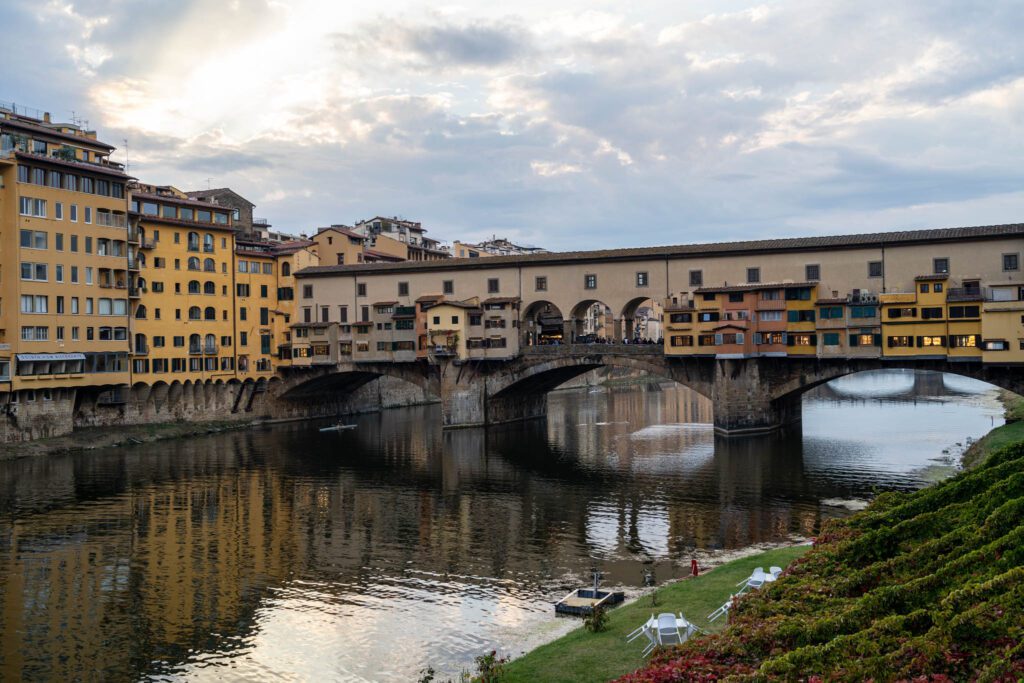10 Incredible Things to Do in Florence (For First Timers)
Wondering what to do in Florence? You’ve come to the right place! Though both of us had been to the magnificent city of Florence before – each for a couple of days – we decided to devote a full 5 days to this Renaissance-rich city on our latest trip to get a level deeper than most people do.
What we found below Florence’s beautiful surface is a city rich in history, architecture, and natural beauty that is a fantastic place to explore in its own right, and also makes a stellar home base for exploring the surrounding regions.
In this guide to our favorite things to do in Florence, we’re going to do our best to give you a perspective – based on personal experience – on what you should focus your time on. This is not a list of every single possible thing you could do in Florence, though it does include the main sights in Florence – the Uffizi Gallery, Accademia Gallery (home of the David), and the Duomo.
Instead, it’s our recommendation based on our experience and, crucially, it includes all the details you need to plan your trip to Florence – like exactly how to snag Uffizi Gallery tickets, and what part of the Duomo Complex you should focus on.
Planning a trip to Florence? We’ve got some detailed travel guides to help you plan an unforgettable trip.
- How to See the Best of Florence in One Day (24 Hour Itinerary)
- 3 Perfect Days in Florence: Planning the Perfect Florence Itinerary
- Where to Stay in Florence: A Complete Guide to Florence’s Best Places to Stay
- Gluten Free Florence: A Complete Travel Guide for Celiacs
- Where to Find the Best Coffee in Florence: A Specialty Coffee City Guide

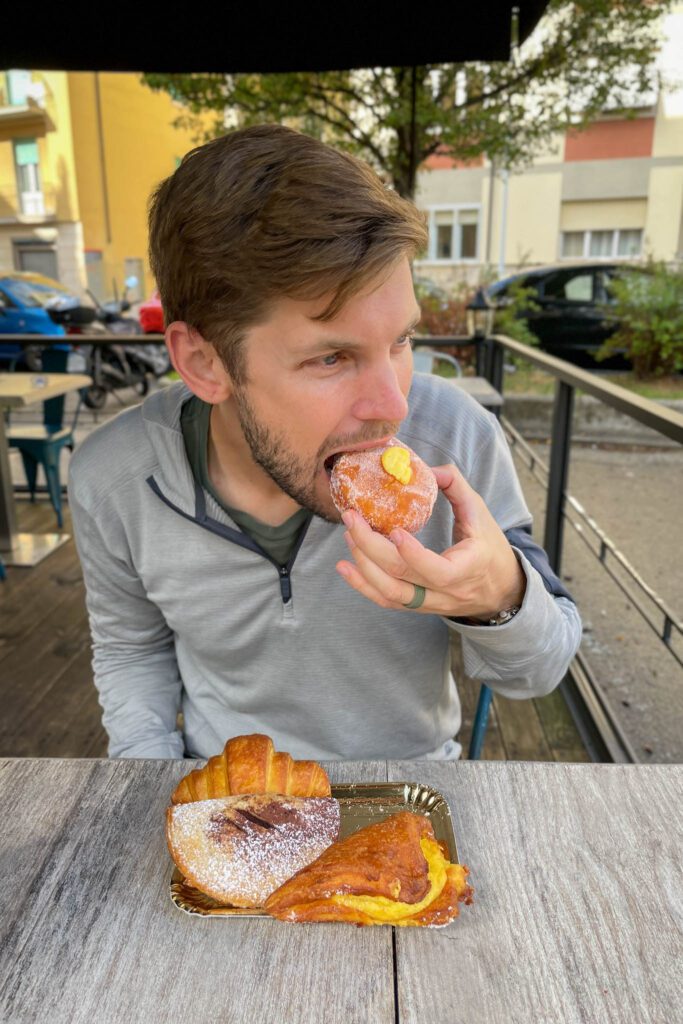

Disclaimer: Some of the links in this post, like hotel links, are affiliate links, meaning at no additional cost to you, we make a little bit of money if you click through and book. That being said, we would never recommend something to you that we don’t stand behind 100%.
10 of Our Favorite Things to Do in Florence (and HOW to do Them!)
Let’s get right into it – below, you’ll find our favorite things to do in Florence, in the rough order in which we’d recommend them. Obviously, some things will take more time than others (e.g. the Uffizi Gallery vs. eating a sandwich), so take the order with a grain of salt.
One other thing to know is that we go into detail on why we believe each thing deserves a spot on the list, and all the practical information you need to actually do it like how much it costs and how to get tickets.
We get really frustrated when we read things, and there’s no actual details that help us plan our trip.
To that point, if there’s something missing or something has changed, please please please let us know so we can fix it!
Lastly, you’ll find some other information about Florence – like how to get around, where to stay, and more – below the guide to what to do in Florence, if you need it.
Planning a trip to Italy? You won’t want to miss our guide to planning an incredible Italy itinerary, with ideas for 7, 10, and 14 days in Italy, how to organize your trip, and the best things to do and see along the way.
Dive Deep into Renaissance Art in the Uffizi Gallery

The Uffizi Gallery is a pretty incredible collection of art. Assembled by the Medici family during their reign in Florence before the building itself, originally an office building for city employees (hence the name, which means offices in Italian), was transformed into a museum in the 18th Century.
Though, at that time, it was kind of an invitation only situation – you had to know a guy (or gal) to get in.
Similar to the Louvre in Paris, it’s absolutely massive. You could easily spend a whole day there and barely scratch the surface.
But I think it’s one of the better-organized art museums I’ve ever been to, which is why it’s near the top of this list.
It’s essentially in chronological order (which is part of the reason we got interested in it after our walking tour guide mentioned it), so you get a real look at the progression of art in Florence from pre-Renaissance era through the Enlightenment period. Which is roughly the 14th Century through the 17th Century, give or take a few decades.
Over the course of a visit to the Uffizi Gallery, you’ll see important works of art from some of the most famous Italian artists, from Giotto, who many art historians (including our guide) view as the father of modern painting, to Leanoardo Da Vinci, Michelangelo, Raphael, Donatello (that rounds out the Teenage Mutant Ninja Turtles) and Carvaggio.
How do you get tickets to the Uffizi Gallery, and should you book a guided tour? Let’s talk logistics!
Taking a Guided Tour of the Uffizi for a Richer, Deeper Experience
I’m going to be completely honest here – we’re not really huge art museum people.
Generally, there’s about a two, maybe three hour window that we can handle before we start getting bored, skipping reading all the signage, and mentally checking out as we mindlessly make our way through the rest of the museum.
It’s just not our favorite thing to do, and recently, in Italy actually, I began to understand why.
I, Matt, just don’t connect with artwork like paintings and sculptures in a vacuum. Mostly because I don’t know anything about those forms of art, and therefore don’t really know what to look for. I was forced to take art class in high school, and it was the only class I ever did poorly in.
As an example, I’m an avid reader of fantasy novels, so if you put a book in front of me and had me read it, I’d be able to have some sort of perspective on it, know what to look for, etc.
Because I have experience both writing (though admittedly not fiction, but still) and reading. However, put a painting in front of me and my reaction is basically “well that’s pretty, I think? Right?”
In Italy, I realized that having a guide – specifically, an expert in art history or a related field – is the difference between me thoroughly enjoying a museum, and me spending two hours walking through, vaguely feeling like I’m missing something.
So, now, whenever I’m doing an art museum, I do it with a guide (or, at the very, VERY least, an audio guide).
We booked this tour of the Uffizi in Florence, and we were glad we did. It was a little bit of a rocky start, with relatively unfriendly office staff and some technical difficulties with the radios (which are essential, by the way – it’s noisy in the gallery, and the radios help you hear the guide so they don’t have to scream), but in the end both Alysha and I really, really enjoyed it.
Our guide, Francesco, really, really knew his stuff, and his passion for the subjects was infectious. He brought a level of expertise that gave us the context behind the artwork we were looking at, and designed the tour to focus on a select few pieces of art, weaving together a narrative that focused on the evolution of art in Florence, with plenty of historical context to go along with it (some of it salacious – how, exactly, did a pope have a son, you might ask?).
The tour took about two and a half hours – longer than the hour and a half it says – and you’ll end the tour inside the gallery, so you can explore more if you wish.
Click here to check prices, reviews, and availability of the tour we did.
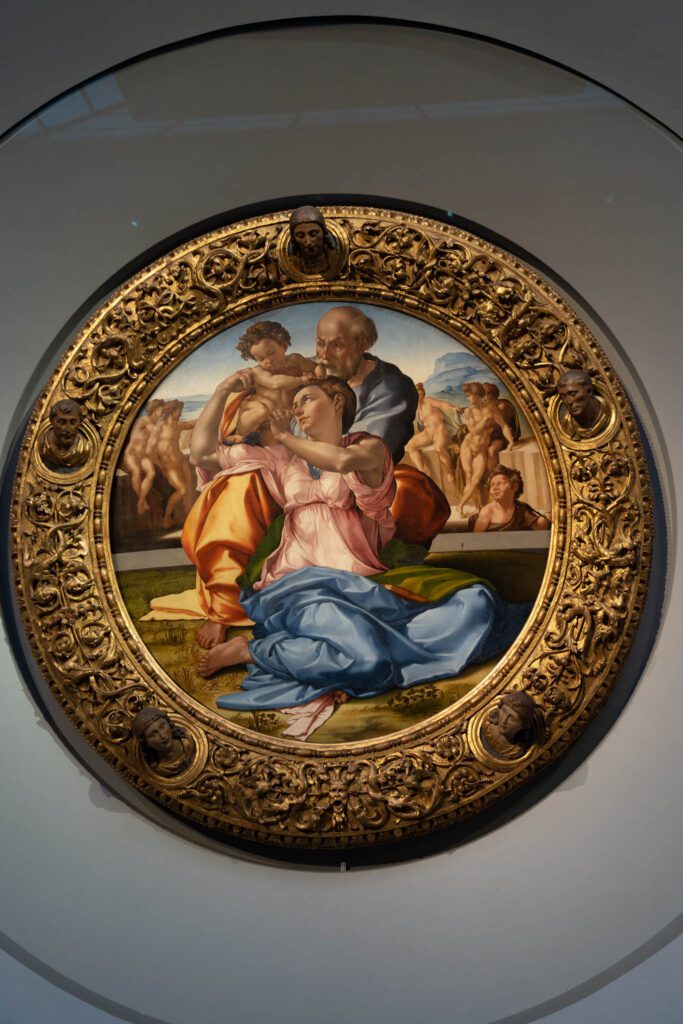
Doing the Uffizi Gallery Independently
Of course, it’s totally possible to do the museum on your own too, which is what we’ll go through here. If you do it this way, I strongly recommend picking up the audio guide, which is well worth the small extra fee.
For reference as we go through the process for getting tickets, you can buy tickets for the Uffizi Gallery here.
Tickets cost 20 Euros per person, and only 2 Euros if you qualify for a reduced price ticket (here is who qualifies for those – basically 18-25 year old E.U. residents).
The first thing you need to know is that while you don’t HAVE to book tickets in advance, you absolutely should if you’re coming in the summer. The lines for the ticket office can be incredibly long, and there’s only a set number of tickets for any given timeslot.
The downside is that it will cost you an extra 4 Euros per ticket to buy them in advance and choose a timeslot, and it will sacrifice a bit of flexibility because you’ll be tied to a time.
After you purchase your ticket online, you will still need to go to the ticket office and exchange it for a paper ticket (which, to be honest, is madness – it’s 2021!), but you get to skip to the front of the line. There will likely still be a line to pick up your paper tickets, but it will be significantly shorter.
The line to buy tickets for the Uffizi Gallery without a reservation in advance is the longest wait you’ll have in Florence if you don’t do it in advance.
Again, BOOK YOUR TICKETS IN ADVANCE. The slight extra cost and reduced flexibility in your schedule will be worth it.
You can also book skip-the-line tickets on Get Your Guide, which will allow you to skip the long ticket line and head straight to the security checkpoint (there will be a line there too, but it’s short and moves fast).
Tips for Visiting the Uffizi Gallery
Here are some things that would be nice to know before your visit.
- The museum is closed on Mondays.
- You can only bring in water bottles that are 500ml or smaller (we learned this right before entry, which resulted in each of us chugging a liter of water).
- You’ll have to check bigger backpacks in the coatroom – my 20L camera bag had to be checked, Alysha’s smaller backpack / sling bag didn’t.
Take a Walking Tour to Understand Florence’s Rich History
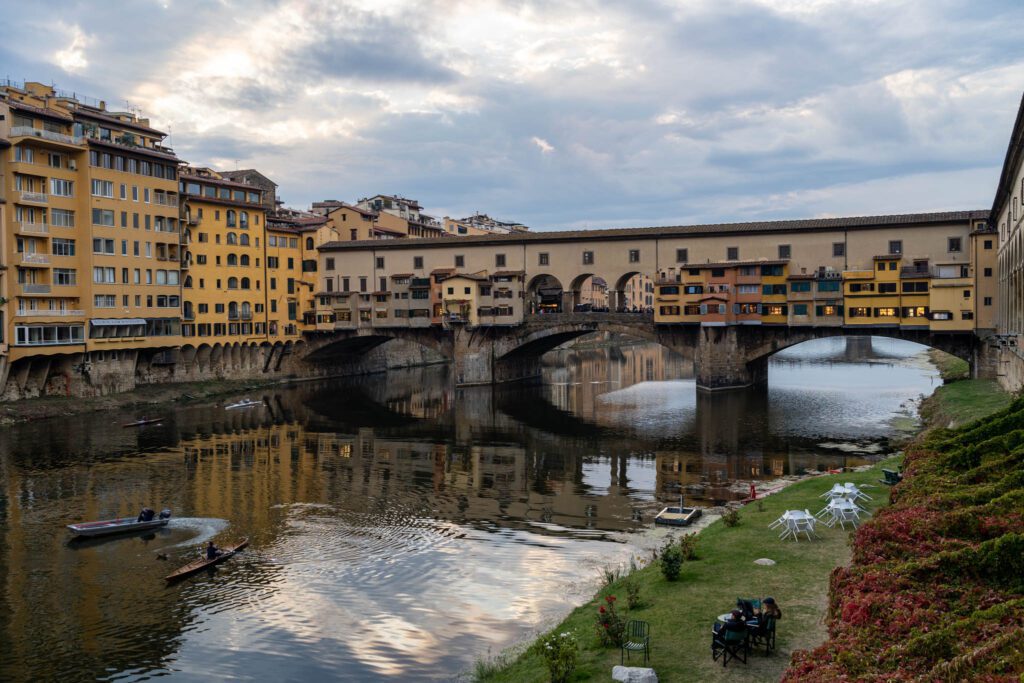
And I do mean “rich” in multiple ways.
First, in terms of wealth. Florence was the banking capital of Europe, and was where the first gold florins that were used as international currency were minted.
Florence was, like, a big deal.
One of the most interesting things we learned on the walking tour was a mindset shift that our guide, Andrea, brought to light.
Florence wasn’t rich because it had a lot of art. It was, in fact, the opposite. Florence had a lot of art because it was rich, and that wealth allowed for the commission of all these amazing works of art.
Second, in terms of history. It has all the makings of a good HBO series – murder, mystery, intrigue, and plenty of salaciousness (again, a pope with a son, who was made the duke of Florence? Questionable at best).
The history of the Medici Family and Florence’s relationship with the Holy Roman Empire and Catholic Church is pretty fascinating, and the best way to learn about it is by taking a walking tour that focuses on that history.
Andrea’s Walking Tour of Florence
We did Andrea’s Walking Tour on our first evening in Florence, and loved it! Andrea is about as Italian as it gets, and we loved the energy and enthusiasm he brought.
His tour is a great overview of the city, and we liked that it was only two hours long, so it’s plenty of time to dive into the history, see some sights, and give you enough knowledge to know what to focus your time on or come back to later, but not so long that it feels like a slog by the end.
You’ll start from Piazza di Santa Croce on the eastern side of the city and make your way to Piazza di San Lorenzo over the course of the tour, with stops at Piazza della Signoria to learn about Cosimo I de’ Medici, the Grand Duke of Tuscany, and see the bronze statue of Perseus, which has stood in the same spot for more than 500 years.
We highly recommend it as an introduction to Florence, and you should do it as early in your trip as you can.
Click here to check prices, reviews, and availability for Andrea’s Tour.
Other Walking Tours in Florence
There are, of course, a bunch of other walking tour options in Florence, but we one other one on our list that we wanted to include here to give you a slightly different option in addition to the one we eventually chose.
The alternative tour we’d recommend is the Take Walks tour of Florence.
We love Take Walks tours, and have done multiple tours with them before, mostly in Rome (read about our Colosseum Tour here!).
They’re particularly good in Italy, which is where the company started. This tour follows roughly the same route as Andrea’s tour, hitting all the highlights, with two major differences.
First is timing – the tour starts at 9:15 am most days, whereas Andrea’s tour is in the afternoon.
Second is the fact that it includes the Galleria dell’Accademia di Firenze and Michelangelo’s David. It’s three hours long, and is a comprehensive look at Florence’s rich history.
Check prices and availability here.
See the Most Magnificent Sculpture on the Planet
I distinctly remember my first time seeing Michelangelo’s David, one of the most incredible sculptures on the planet, in all its glory at the Galleria dell’Accademia di Firenze.
My first thought? It’s bigger than I expected.
I thought that the David was a life-sized sculpture, but it actually stands at 17 feet tall, towering above you as you marvel at the details from below. The project was awarded to Michelangelo – who was born in nearby Santa Croce – in the early 1500’s after a string of other artists tried and failed to shape the huge block of marble into a lifelike sculpture.

We would say that the Accademia Gallery is one of the three things you shouldn’t miss in Florence, along with the Uffizi Gallery and the Duomo di Firenze (specifically, the view from the roof and the art on the inside of the dome).
The Accademia Gallery is really all about the David, though there are a couple of other noteworthy pieces that you should spend some time exploring.
There are two replicas of the David in Florence, one is in Piazza della Signoria outside Palazzo Vecchio, in a location where the original lived before it was brought into the Accademia, and the other is up at Piazzale Michelangelo.
You essentially have two options to see the Galleria dell’Accademia. You can pre-book tickets yourself (and yes, we’d highly recommend pre-booking), or you can join a guided tour. If you want to do it on your own, you should know that tickets sell out months in advance for peak season (aka the summertime), so book as early as humanly possible.
If you’re planning a trip at the last minute and tickets are sold out, jumping on a guided tour is the best way to see the David.
One other thing we’d note – if you only have the time or budget for one guided museum tour in Florence, we’d choose the Uffizi Gallery because the tour there adds more richness and color than the Accademia tour will.
That’s not to say a guided tour isn’t worth it for the Accademia, it’s to say the tour of the Uffizi is more helpful in understanding the art, history, and culture surrounding the works of art you’re looking at.
Note: The museum is closed on Mondays.
Visiting the Galleria dell’Accademia Independently
If you want to visit the Gallery independently, your first task is to book tickets well in advance. As soon as you know your dates for Florence, you should hop on booking tickets for the Accademia.
You can find information here – we’d recommend booking through B Tickets, which is what we used for the Boboli Gardens in Florence. Tickets cost 16 Euros (reduced tickets for EU citizens between 18 and 25 years old, and free tickets for anyone under 18).
You’ll need to choose a timeslot, which is a 15 minute window during which you are able to enter the museum. After talking to a guide, we’d recommend a lunchtime or late afternoon timeslot, which is the least busy time of day. First thing in the morning through lunch is the busiest time to be in Florence’s museums.
Note that there is a 4 Euro fee for pre-booking tickets, but it’s a crucial step to avoid waiting in line at the ticket office AND at the entrance, so we think it’s 100% worth it.
You can also pre-book skip-the-line tickets here, which is roughly the same price and doesn’t involve navigating the sometimes confusing official website.
Visiting the Galleria dell’Accademia on a Guided Tour
There are two reasons why a guided tour might be a good choice for you. First, you’re planning your trip to Florence at the last minute, and tickets for the Gallery are already sold out for your dates. Second, if you want more context and are interested in the story around the David and how it came to be.
We generally opt for guided tours of most art museums at this point because we find the added richness that an expert can provide is well worth the money. Otherwise, we kind of just wander around semi-aimlessly, and don’t really know what to look at or the stories behind the art.
There are two basic categories for guided tours of the Accademia: tours that focus exclusively on the Accademia Gallery, and tours that have the Gallery as part of a broader Florence walking tour. Which one you choose largely depends on you, your interests, and your Florence itinerary.
If you want a guided tour solely of the Accademia Gallery, we’d choose this tour, which is highly reviewed, takes place around lunchtime when crowds start to thin, and has options for one and two hour durations, which gives you options in terms of your budget for both time and money. Click here to check prices, reviews, and availability.
If you want a broader Florence walking tour that includes a visit to the Accademia, we’d go with Take Walks, a company we love and have done multiple tours in Italy with (read about our myth-shattering Colosseum Tour in Rome). They have a VIP David & Duomo tour that includes both the Accademia and a climb to the top of the Duomo’s dome. Click here to check prices, reviews, and availability.
Climb 400+ Stairs to the Top of Brunelleschi’s Dome
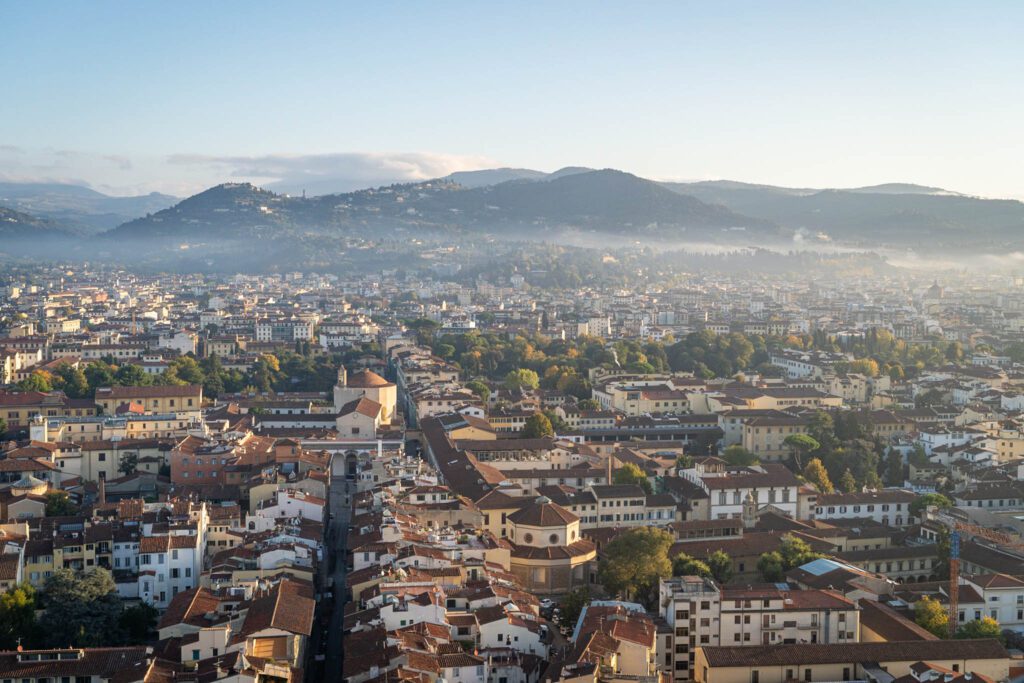
First of all, you MUST book your tickets in advance for this one. It’s not optional. You have to buy tickets in advance with a specific time slot.
At 20 Euros a person, the price is a little steep (so are the stairs) to visit Brunelleschi’s Dome, which is the dome on top of the Florence Cathedral, and is probably the most iconic thing in Florence. Thousands of tourists flock to Piazza del Duomo every day to see the masterpiece that Brunelleschi – who was not, in fact, an architect, but a goldsmith at the time – created in the 15th Century.
But the view is sublime. From the top, you get a 360 degree view of Florence and the rolling green hills of Tuscany.
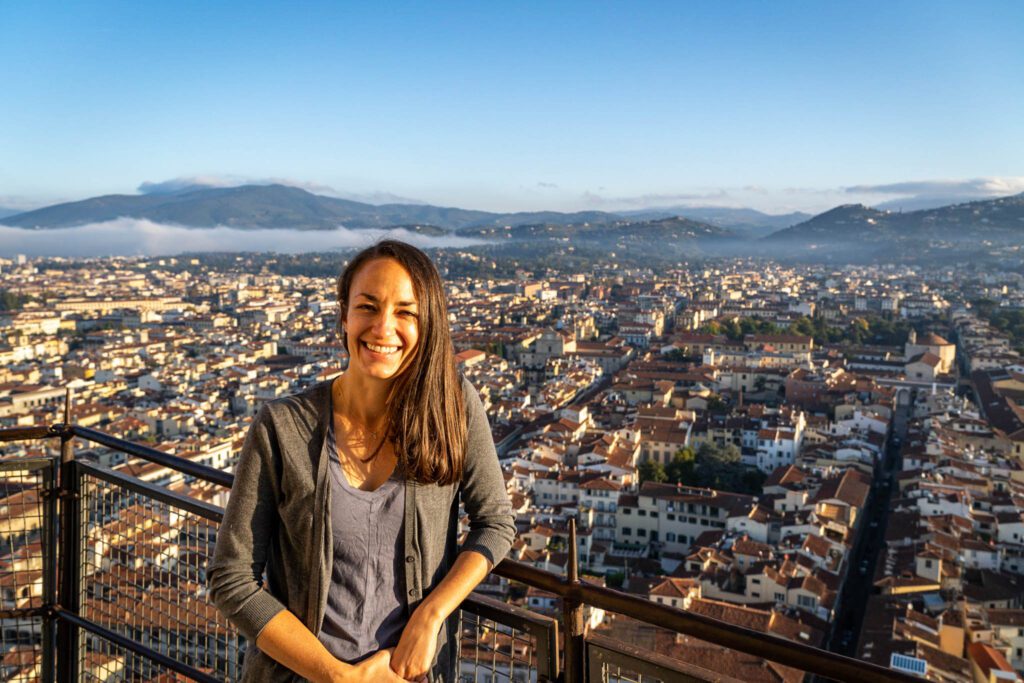
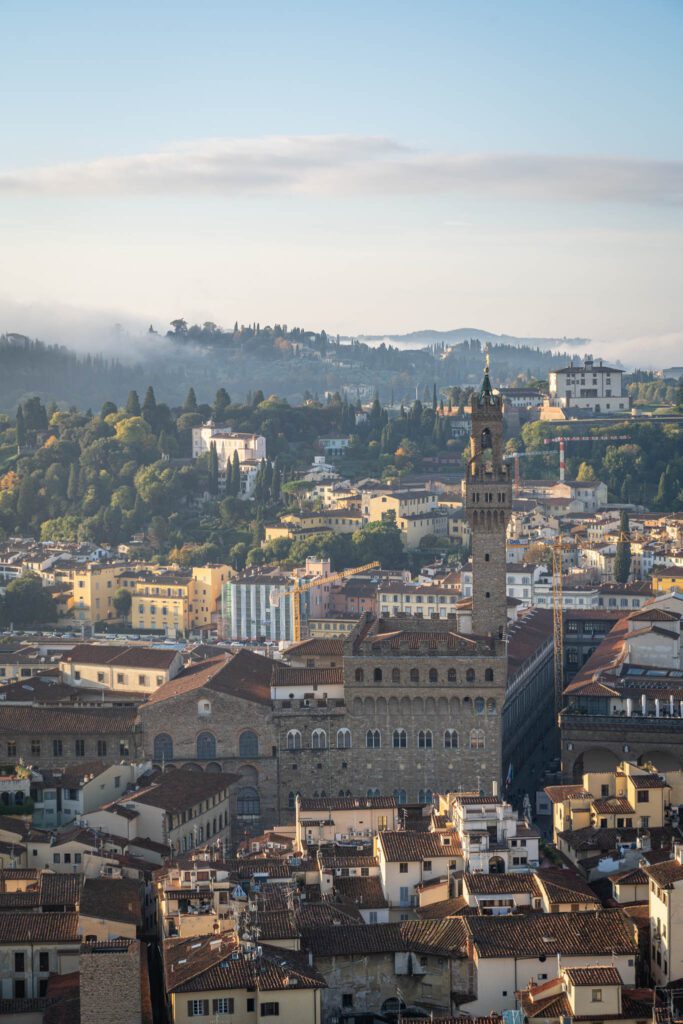

Climbing Brunelleschi’s Dome: What to Know Before You Go
You are going to be climbing 450+ stairs (Matt counted, and got a slightly different number than the supposed 463 that is often quoted) to reach the dome, and there’s no elevator or alternate way to do it. There are parts that are steep, parts that are narrow, parts that are both steep and narrow, and you will likely be sharing the experience with many other people.
There’s a point where you are shuffling along a narrow balcony (behind a glass wall, of course, it’s not like you’re at risk of falling) around the base of the dome high above the floor of the church below, which is spectacular. From there, you can see the details in the art on the interior of the dome, which is worth stopping to admire.
However, by stopping to admire, and everybody else doing the same, you will be standing there, suspended several hundred feet up on a narrow ledge, which isn’t for everyone. Alysha was a little antsy to be done with it after about five minutes, which is why I’ve included this little blurb. I’m not a fan of heights, but I was totally fine on this one.
If you are scared of heights, claustrophobic, or unable to climb 450+ steps to reach the top of the dome, think twice before you embark on the journey (and, more importantly, spend the 20 Euros a piece).
Buying Your Tickets for the Dome
Again, you must buy your tickets to climb to the Dome in advance, and they will cost 20 Euros (10 Euros for reduced price tickets, if you qualify).
The website to buy tickets for the Dome is here. You’ll follow that link, click on “Brunelleschi’s Dome,” then choose a date and time slot and go from there.
Alternatively, if you want to avoid the sometimes confusing official website, you can book skip-the-line tickets here, which are exactly the same thing – tickets for entry to the Dome.
We’d really, really urge you to choose a time slot either early in the day (the first available) or late in the day (the last available) for the best light.
There’s something surreal about being atop the dome and seeing the landscape awash in a soft, golden glow of the setting sun (which is really only possible outside of the summer months, when the sun sets earlier).
If tickets are sold out for the days you’ll be in Florence, you can still access the Dome by booking a guided tour.
In fact, that might be your only option at that point. We’d opt for this guided tour, which is two hours long and includes both a climb to the Dome, and a walk around the exterior to learn about the history of the massive cathedral.
Wander the Boboli Gardens
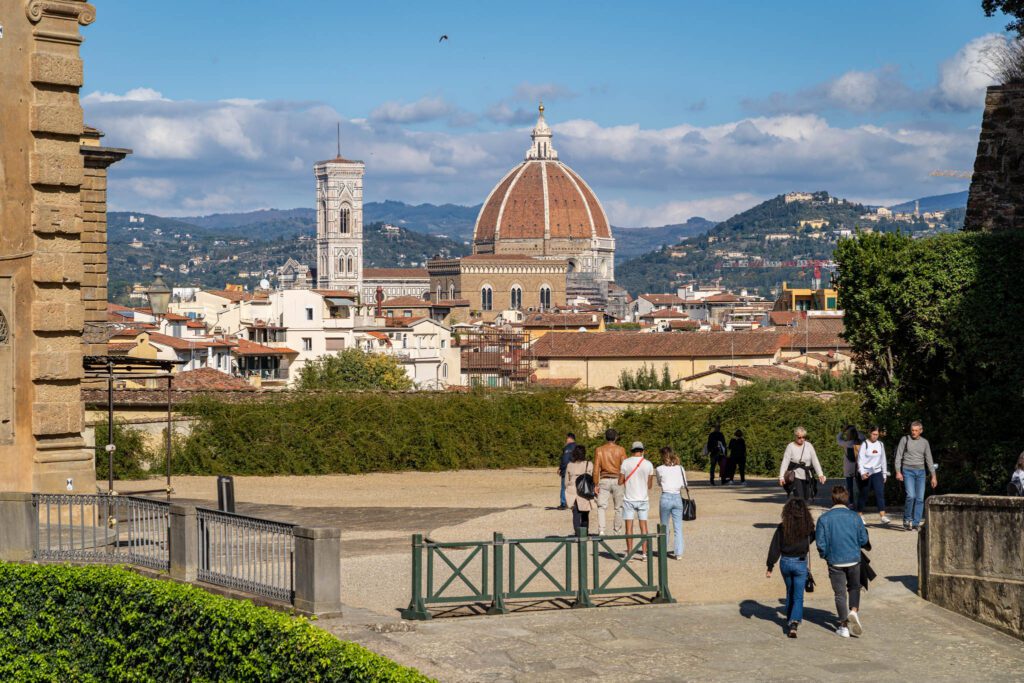
While we decided to skip the Palazzo Pitti after hearing from a local that it wasn’t particularly well organized (and that we should do Uffizi and Accademia instead), we did do the Boboli Gardens and enjoyed our hour spent wandering the grounds of the former Medici Palace.
As soon as you enter the gardens, you’re met with one of the best views in the entire city, with the Duomo and the center of Florence off in the distance. Not a bad view for the richest family in the city to enjoy from their palace.
As far as your route goes, we’d definitely recommend including the botanical garden, the fountain of Neptune, and the Fontana dell’Oceano.
As you enter the gardens, we’d head off to the right towards the botanical garden, down to the Fontana dell’Oceano, and then around the back of the gardens to see the Fountain of Neptune from above. Something like this, roughly.

Note: The entrance to the gardens is the same as the entrance to Pitti Palace (here on Google Maps). If you’re looking at Pitti Palace, the ticket office is off to the right.
Get your tickets in advance – the ticket line can be very, very long, and you get to skip right to the front if you already have tickets. You will still need to exchange your electronic tickets for paper tickets, though, which surprised us. Again, though, you skip the line, show a barcode, and off you go! Learn more and get tickets here.
Eat a Schiacciata on Via di Neri
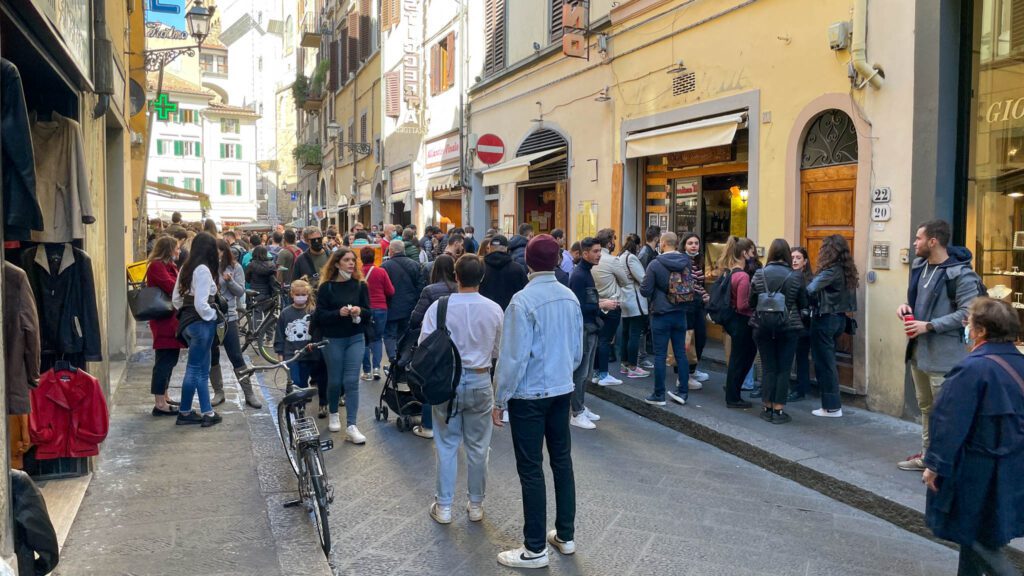
When we exited the Uffizi Gallery after our tour around lunchtime (side note: we did this one with our guide, Francesco, and loved the richness and detail he brought to the experience – highly recommended!) and we immediately saw a huge line of people waiting for…something?
Oh, we thought, that must be the line to get tickets for the gallery.
Wrong!
It was the line to get a sandwich from All’Antico Vinaio, which is one of the most reviewed restaurants in the world on all sorts of platforms, which means hundreds of tourists flock there every day to get their hands on one of their Insta-famous focaccia sandwiches. This place is so popular that they’ve expanded worldwide!
In Florence, those delicious looking sandwiches you see everyone walking around with around lunchtime are called “Schiacciata” (we also have seen Schiacciate, which I think is the plural form).
It’s a very popular form of street food in Florence, which we learned when we saw multiple different shops selling essentially the same thing, all with long lines pouring into the street.

The sandwich itself is basically two pieces of focaccia (though, I want to be clear – it’s not focaccia, it’s made differently and with more salt than your typical focaccia), with some sort of cured meat, a cheese, and some other accoutrements stuffed in between.
We had one from Sgrano – which is a 100% gluten free restaurant in Florence that’s just down the street – that had pancetta, gorgonzola, peppers, and honey, and it was fantastic.
Anyway, this is not an advertisement for the most famous sandwich shop in Italy – like they need more press – this is instead a recommendation to head to the street it’s on for lunch, and get your hands on a sandwich from one of the many vendors on the street stuffing them with all sorts of meats, cheeses, vegetables, and even seafood.
It’s a relatively cheap, filling lunch option, and if we were you we’d grab it to-go and head towards the Arno River to find a spot overlooking Ponte Vecchio and enjoy it with a view.
Explore the Other Side of the Arno
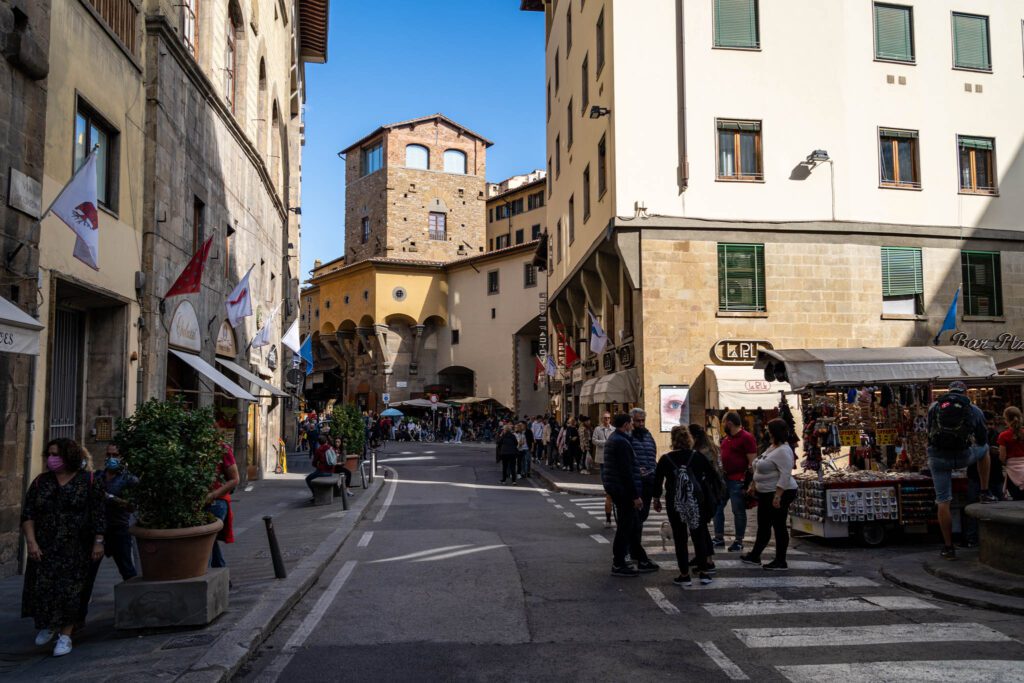
Oltrarno turned out to be one of our favorite parts of the city, and it feels slightly less hectic and full of tourists than the historical center despite being less than ten minutes away on foot. Just across Ponte Vecchio, the “local’s Florence” (according to Andrea, our walking tour guide) begins.
The opposite side of the river is full of great restaurants, cafes, and other local businesses and it is well worth an afternoon of your time.
For an excellent tour of Oltrarno, start by crossing Ponte Vecchio and heading up to explore the Boboli Gardens.
Grab coffee at Ditta Artiginale, one of the best coffee shops in Florence, and then head just down the street for some of Alysha’s favorite gelato in Italy at Gelateria Della Passera.
Head over to bustling Piazza Santo Spirito for some of the best people watching in Florence, then make your way east, walking through the rose garden to get up to Piazza Michelangelo, which is the best view in Florence (though you’ll share it with a bunch of people at all hours of the day).
Once you’ve had your fill of amazing views, drop down into San Niccolò and walk through Porta San Niccolò, one of the original gates into the city, and cross back over the river.

Explore Two of Florence’s Food Markets
There are two main food markets in Florence, and we think both are probably worth a visit, though they offer slightly different things.
Mercato Centrale: Bigger, More Central, and More Touristy
The First is Mercato Centrale, which is northwest of the Duomo (find it here on Google Maps). Technically, this is made up of two separate markets – the Mercato di San Lorenzo (which is the ground floor) and Mercato Centrale (which is the food hall on the top floor).
This one is significantly more touristy, and has three main components.
Outside, there is what we’ll call an artisan market, which is full of stalls selling everything from handmade (allegedly) leather goods to phone cases and scarves. Fun fact: Matt bought a leather messenger bag at this exact location nearly a decade ago, and still uses it occasionally (when, you know, he leaves the house).

On the ground floor inside the market, there’s a mix of fresh produce stands selling seasonal fruits and vegetables coming in from the fertile farmland of Tuscany, butchers and cheesemongers, and what we’ll call “tourist shops” selling a smorgasbord of different Tuscan delicacies, all conveniently packaged in a way to make them perfect souvenirs or gifts.
You can get all sorts of things – wine, truffle-flavored things, crema di pistacchio (YUM), and more. It’s a good place to shop for things to take home, though it’s a little expensive and not authentic.
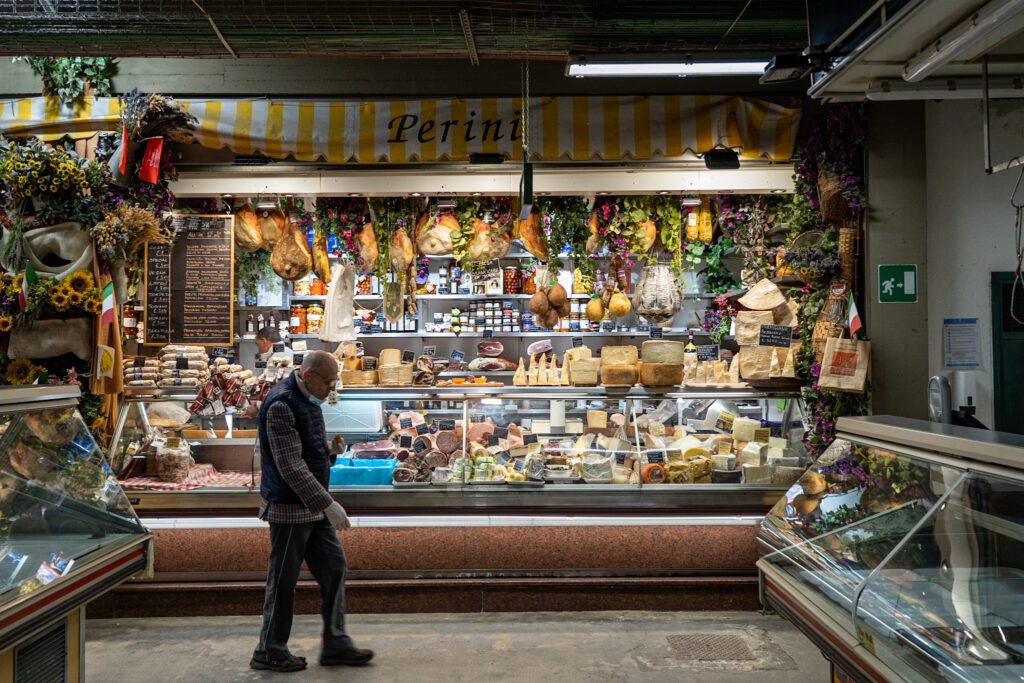
The top floor consists of a food hall, with all sorts of stalls serving up everything from authentic Tuscan cuisine to sushi, and just about everything in between. However, the star of the show based on the line was clearly Pasta Fresca, which is actually downstairs in a corner of the market.
There were 20 people crowded around the tiny hole-in-the-wall, devouring handmade pastas. Obviously not gluten free, so we skipped it, but we noted it as somewhere we would have loved to try!
Hours: The ground floor is open Monday to Saturday from roughly 8:00 am to 2:00 pm, and the Food Hall is open daily from 10:00 am to midnight.
Mercato Sant’Ambrogio: More Low-Key and Local
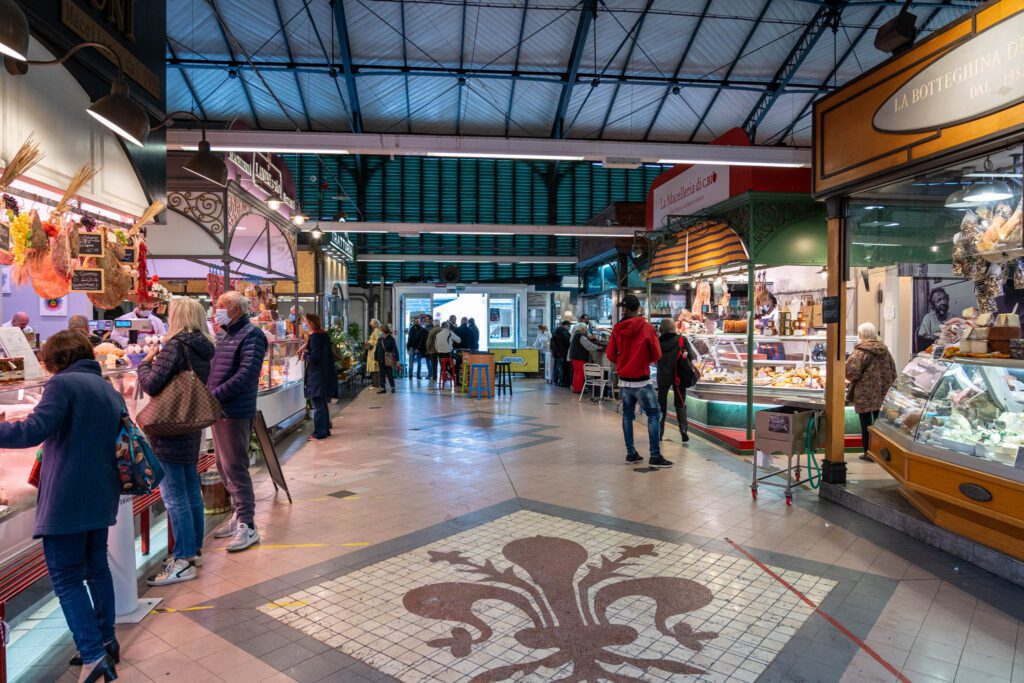
Significantly less famous and visited than Mercato Centrale, we really enjoyed Mercato Sant’Ambrogio, and ended up buying an array of cheeses from one of the vendors there to build our own cheese plate at home.
There are a bunch of stalls indoors, which are selling a mix of fresh ingredients like meats, fish, and cheeses, and fresh food that is ready to eat now.
Along the exterior of the market, you’ll find what is essentially a farmers market, with local vendors selling freshly picked produce, and mostly locals going about their shopping. There was even a stand with an entire fully cooked pig’s head, which I’ve never seen before. There’s also a part of the market that’s more like a flea market, with gadgets and clothes being sold.
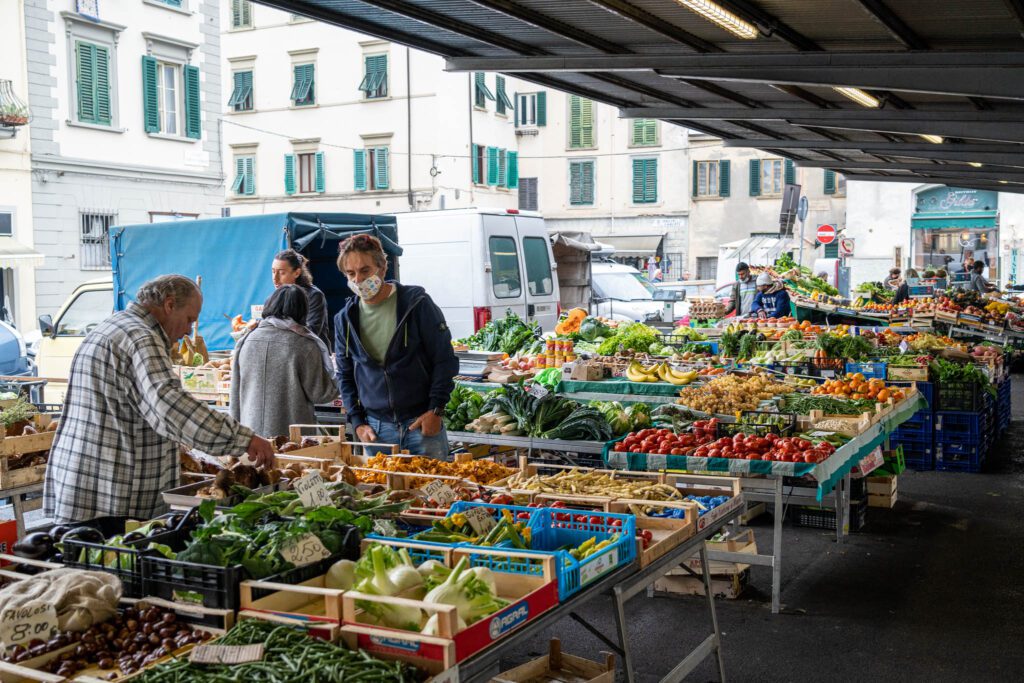
It’s about as authentic as central Florence can be, and we heard far, far more Italian being spoken here than just about anywhere else in Florence.
Around the corner, you’ll find one of the best coffee shops in Florence – Coffee Mantra – and the best tea shop in Florence is directly across the street from the market – The Way of Tea.
Hours: Monday to Saturday, 7:00 am to 2:00 pm.
Enjoy the Best (Free) View in Florence at Piazzale Michelangelo

First of all, a visit to Piazzale Michelangelo should absolutely be on your visit to the other side of the river, which we already covered above.
Second of all, we think this view is better than the view from the top of the Duomo – which is also amazing – because it includes… the Duomo. From Piazzale Michelangelo, which is up on the hill across the Arno from Santa Croce, you get a sweeping view out over the city of Florence that includes the Duomo, Palazzo Vecchio, and Ponte Vecchio.
It’s spectacular, which is why it’s also insanely popular. At sunset, hundreds and hundreds of people flock to this viewpoint.
Which is exactly why we’d like to suggest an alternative: the early morning visit. First, the crowds will be much, much thinner. You’ll have the place mostly to yourself, with a few other early risers and likely some runners who have this view as part of their daily route.
Second, the light can actually be better in the morning. Depending on the time of year, sunset could mean that you’re facing the sun, which makes getting spectacular pictures fairly difficult. In the morning, the sun will be coming over your shoulder, illuminating the Duomo and Florence skyline, which makes for much better pictures.
There’s a replica of the David up on the terrace, but it’s just that – a replica.
Take a Day Trip – There’s a Bunch of Them!
One of our favorite things about Florence is how central it is. Seriously, from Florence, you have most of Central Italy at your fingertips. Or at least within a couple of hours of your fingertips, anyway.
Here are a few day trips from Florence to consider, depending on what you’re interested in.
If you want wine, do a wine tasting tour from Florence that takes you into the Tuscan wine country just outside the city limits.
You have two options – do a tour that visits multiple wineries and includes transportation (like this one or this one), or go DEEP with a single winery, and deal with getting to and from the winery on your own (like this one or this one).
The former is easier, the latter is cheaper. They’re both great ways to experience one of the most famous wine regions in the world.
If you’re a foodie, go to Bologna – widely regarded as one of the best food cities in Italy – and gorge yourself on prosciutto, parmesan, balsamic vinegar, tagliatelle alla Bolognese, and anything else you can get your paws on.
If you want to see charming Tuscan hilltop towns that the region is famous for, head to Siena or San Gimignano. Here’s a full day Tuscany trip with one of our favorite tour companies in Italy- Take Walks – that includes transportation and a trip to both towns PLUS wine tasting.
Our favorite stop on our latest trip to Italy was Verona, which is about 90 minutes away from Florence by high speed train (it’s too far for a day trip if you don’t use the high speed train). Here’s our guide to spending a day in Verona.

We loved our day trip to Lucca, where you can walk the entire way around the city on top of the completely intact medieval walls for some pretty spectacular views.
You can also do Pisa, but we’d honestly opt for one of the options above before that – the leaning tower of Pisa is really the only reason to go, and you’ll be amidst hundreds (thousands) of tourists all trying to get the same picture.
Read More: 9 Spectacular Day Trips from Florence to Add to Your Itinerary
